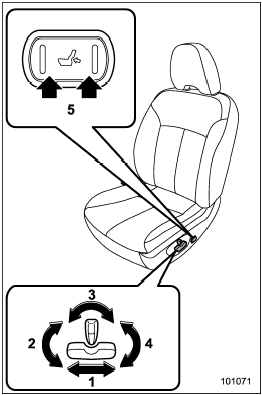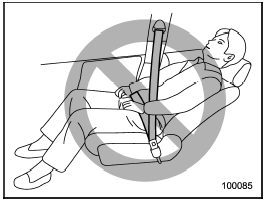Power seat (driver’s seat – if equipped)

1) Seat position forward/backward control switch
To adjust the seat forward or backward, move the control switch forward or backward. During forward/backward adjustment of the seat, you cannot adjust the seat cushion angle or seat cushion height.
2) Seat cushion angle control switch
To adjust the seat cushion angle, pull up or push down the front end of the control switch.
3) Seatback angle (reclining) control switch
To adjust the angle of the seatback, move the control switch.
4) Seat height control switch
To adjust the seat height, pull up or push down the rear end of the control switch.
5) Lumbar support control switch
To increase lumbar support, push the front side of the switch. To decrease lumbar support, push the rear side of the switch.


To prevent the passenger from sliding under the seatbelt in the event of a collision, always put the seatback in the upright position while the vehicle is in motion. Also, do not place objects such as cushions between the passenger and the seatback. If you do so, the risk of sliding under the lap belt and of the lap belt sliding up over the abdomen will increase, and both can result in serious internal injury or death.
See also:
Children
If a child is too big for a child restraint system, the child should sit in the rear seat and be restrained using the seatbelts.
According to accident statistics, children are safer when properly res ...
D (Drive)
This position is for normal driving. The transmission automatically shifts into
a suitable gear according to the vehicle speed and the acceleration you require.
When more acceleration is required ...
Low fuel warning light
The low fuel warning light illuminates
when the tank is nearly empty [approximately
2.6 US gal (10.0 liters, 2.2 Imp
gal)]. It only operates when the ignition
switch is in the “ON” position.
...


